+++ Für die deutsche Version bitte nach unten scrollen +++
Let’s start with some good news: the lost luggage we were all so worried about arrived on time and so complete in terms of scientists and material we left the harbour of Suva in broad day light with lots of sunshine. There was no time really to get used to the movement of the ship, because within 36 hours of leaving port, we were to deploy the first Ocean Bottom Seismometer (OBS) station, which meant all hands on deck.
The sunny weather with which we left port unfortunately did not last very long, the weathergods like to tease us. It started raining and I’m not talking about a light drizzle, no, it was pouring, like somebody pulled the plug from a sink and we were standing right below it. In no-time I was completely soaked. Luckily the outside temperature was still over 25 oC so it was not that cold, just very wet. When you have to go outside in very rainy weather, we have a saying in The Netherlands that goes like this: ‘we are not made of sugar’. It means that you won’t melt in the rain (like a sugarcube would do) and so you would just go outside and work, and that’s exactly what we did.
It was good that we continued working even though the weather was more like at home than expected. For almost two days after the deployment of the first station we continued assembling equipment, attaching it to a buoyant frame and letting it go into the Pacific Ocean. In between the deployment of the OBS stations, we also set out some Magnetotellurics (MT) stations and we did some heat flow measurements.
I will briefly explain what kind of data every method acquires. The OBS stations have geophones that record shockwaves that are produced by airguns, which are towed behind the ship. The shockwaves travel through the layers of the earth’s crust and sediments and get refracted and reflected. The OBS stations record the refracted waves which can be used to produce images of the subsurface. This will provide us with information about the crustal structure of the Lau Basin.
The MT stations have a similar appearance as the OBS stations, but instead of geophones the MT stations have four 5-meter long tubes attached on every corner of the station. Inside the tubes there are electrolytes that consist of a membrane adapted to salty waters. The electrolytes measure the geoelectric and geomagnetic field at the Earth’s surface to capture the electrical conductivity of the rocksat the bottom of the ocean.
Last but not least we took also took heat flow measurement along the same profile. The heat flow probe looks like a very big needle which is attached to a cable and lowered into the water in a vertical position. It is designed to penetrate into the sediments that cover the ocean floor. Once the heat flow probe wiggles its way into the sediment it will measure the temperature and the conductivity of the rock for some minutes after which it is recovered again.
Thanks to our efficient work in these first few days, we managed to complete the deployment of all OBS and MT stations and do all the heat flow measurements ahead of the planned schedule. The airguns are towed behind the ship as I am writing this. For the next few days we will be acquiring seismic data, first the refraction seismic data after which we will also deploy a streamer. The streamer will be towed behind the ship and record all the reflected shockwaves. Once that’s done, we will start with the most exciting, if you ask me, the recovery of the OBS and MT instruments. If all goes well, we should recover 61 stations in total. This is quite a challenge, but I am convinced that we will be able to do so, but…. more on this later.
Warm greetings from the RV Sonne!
Written by: Anouk Beniest
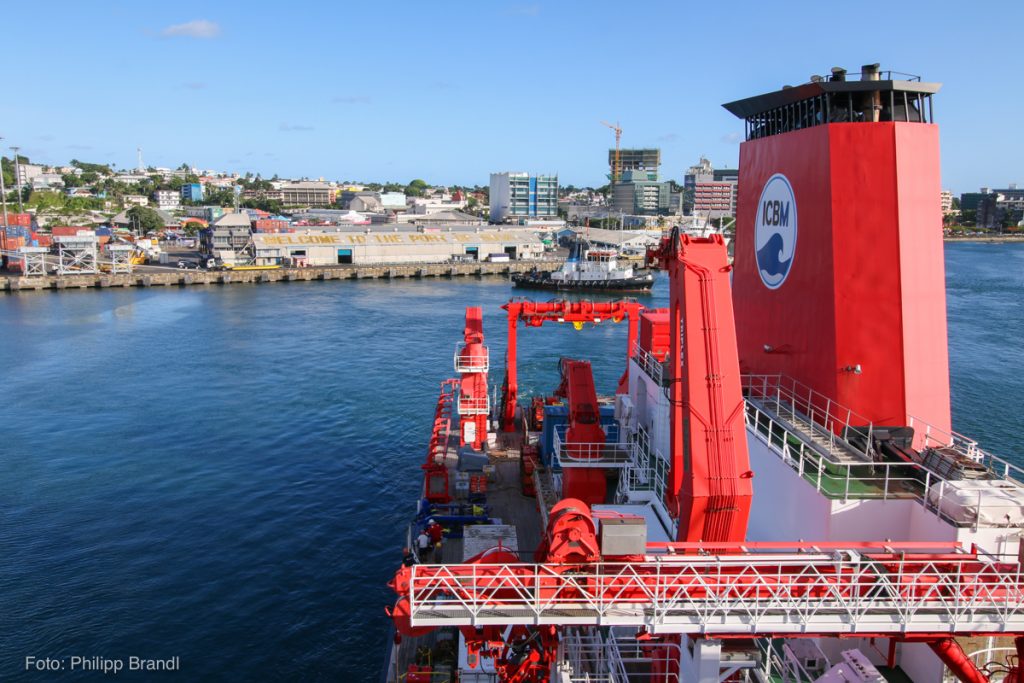
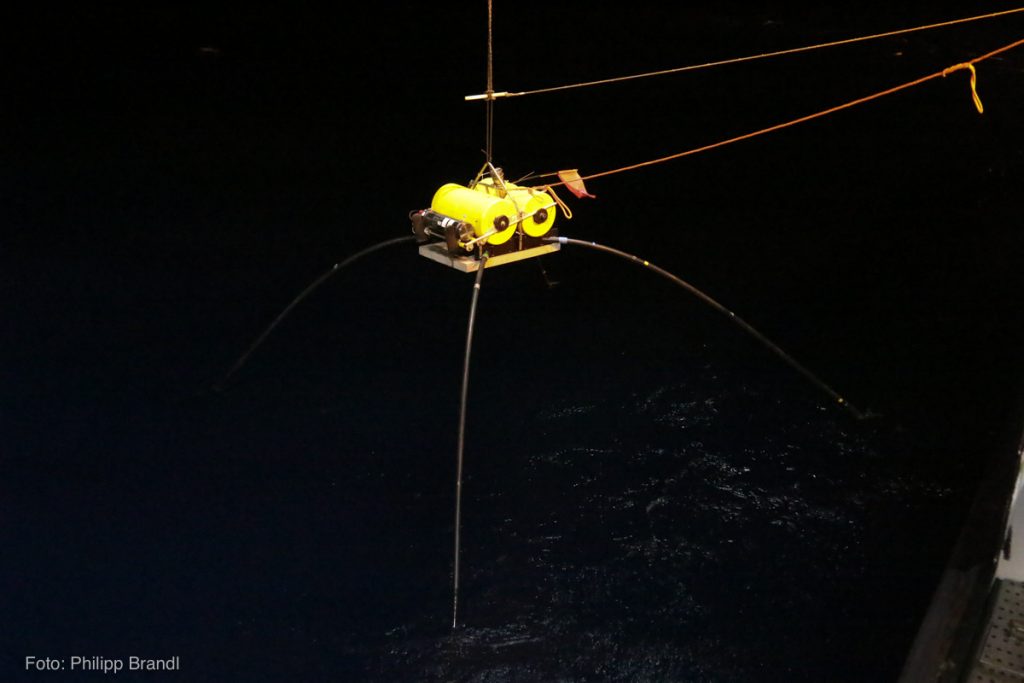
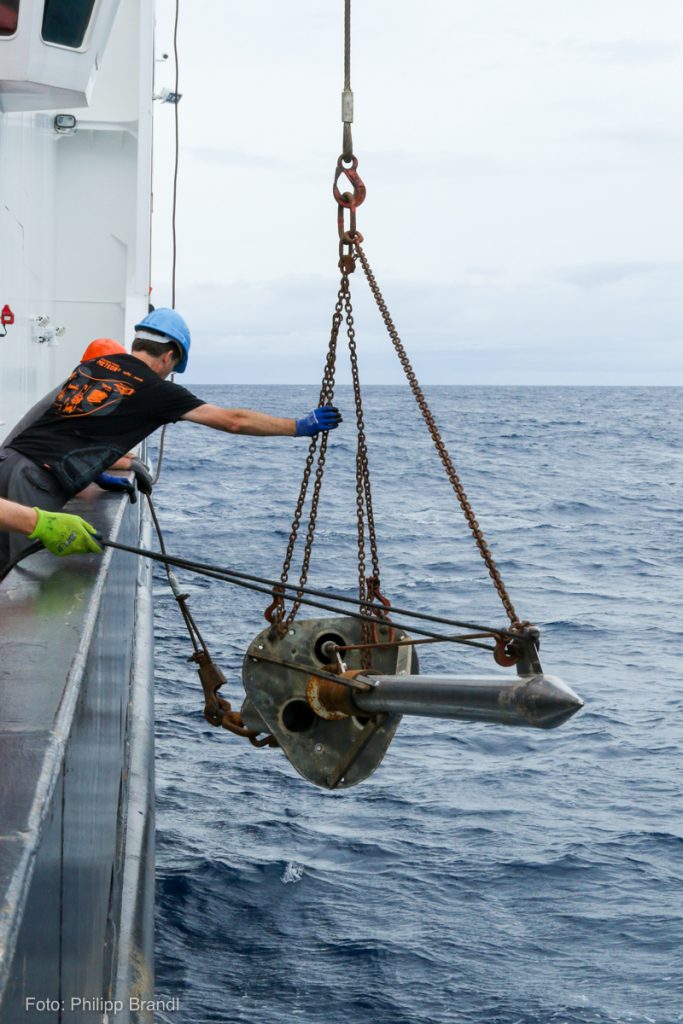
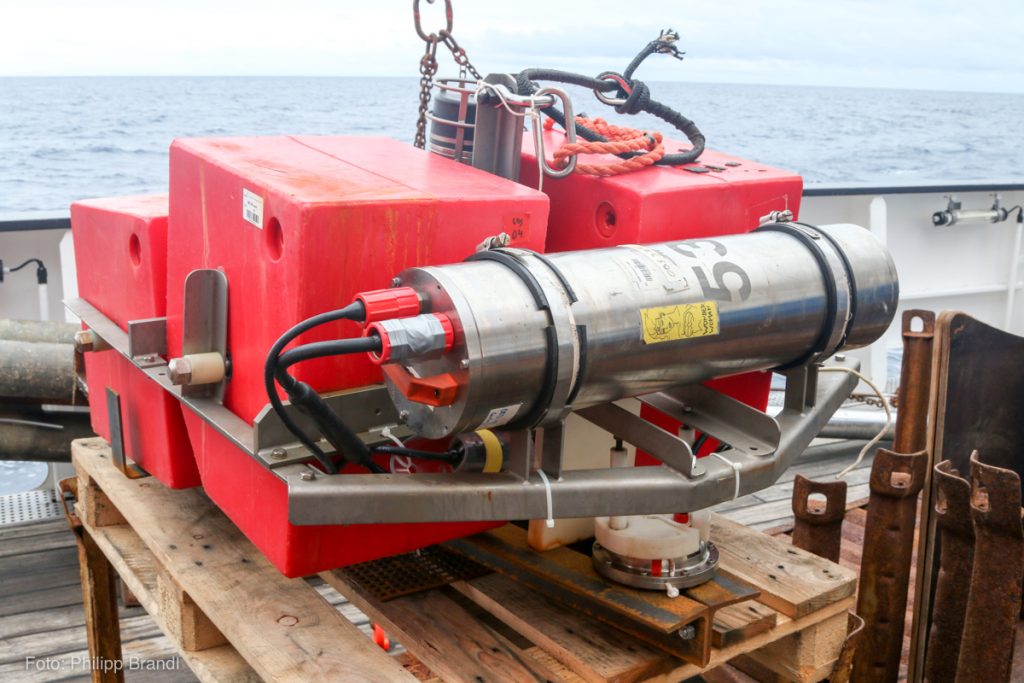
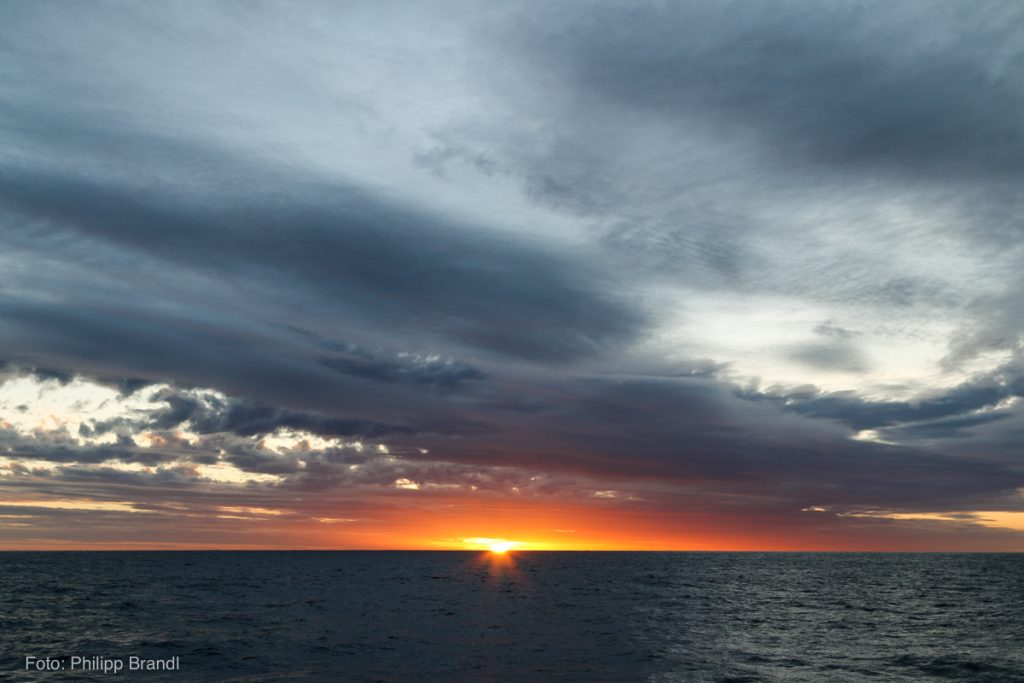
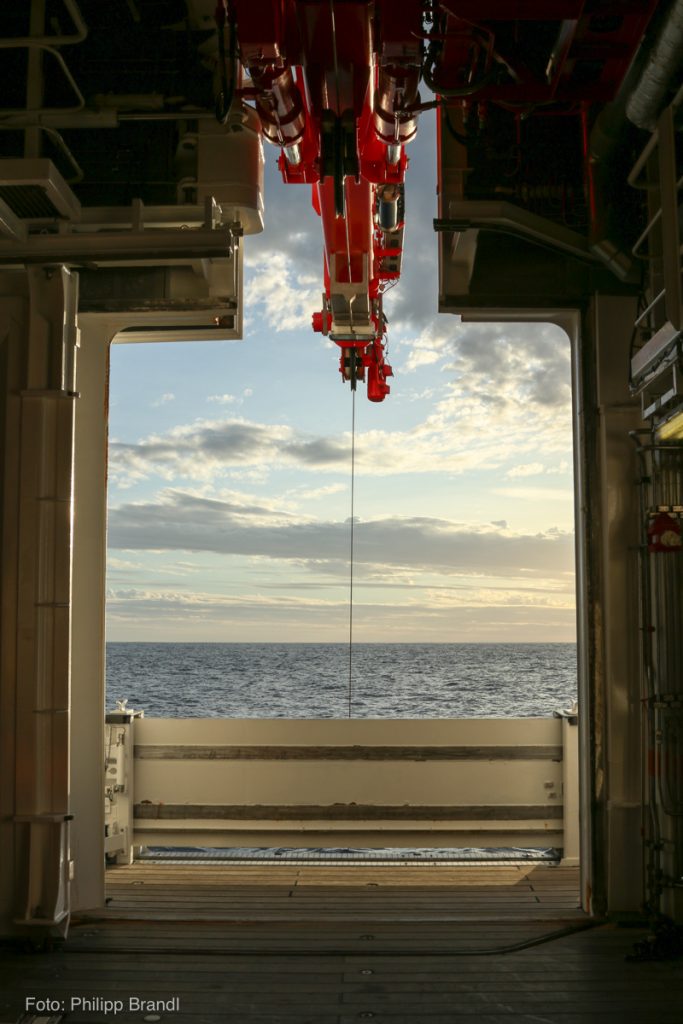
Eine volle erste Woche der Archimedes-I Ausfahrt
Um die brennendste Frage als erstes zu beantworten: das verspätete Gepäckstück ist noch rechtzeitig angekommen. Daher konnten alle Wissenschaftler zufrieden und beruhigt den Ausblick auf das immer kleiner werdende Suva genießen, als die FS Sonne bei strahlendem Sonnenschein den Hafen verließund wenn auch nur für kurze Zeit. Die Kürze des Transits in das Forschungsgebiet ließ jedochkeine Zeit für einen langen Abschied von Suva.
Kaum aus dem Hafen wurden auf noch wackeligen Wissenschaftlerbeinen, die sich noch nicht ganz an die Bewegung des Schiffes gewöhnt hatten, Ocean Bottom Seismometer (OBS) und Ocean Bottom MagnetoTelluric (OBMT) Stationen vorbereitet. Das Aussetzen der Geräte erfolgte einen Tag später entlang des ersten Profils abwechselnd mit Messungen des Wärmeflusses. Obwohl sich mittlerweile alle an das leichte Schaukeln der FS Sonne gewöhnt hatten, war das Aussetzen alles andere als ein Zuckerschlecken. Denn trotz der gemeinsamen Wünsche von WissenschaftlerInnen und Schiffsbesatzung hielt das trockene, warme Wetter des ersten Tages natürlich nicht an. Während der intensiven Arbeit an Deck gab es immer wieder wolkenbruchartigen Regen der alle bis auf die Knochen durchtränkte, was bei 25°C Außentemperatur jedoch nicht weiter schlimm war und der Motivation keinen Dämpfer verpasste. Schließlich sind wir ja nicht aus Zucker und die späteren Erzählungen von unserer Arbeit klingen dann umso eindrucksvoller! Zwei Tage lang wurden die verschiedenen Geräte programmiert, zusammengeschraubt, an Schwimmkörpern befestigt undschließlich am Meeresboden desPazifischen Ozeans ausgesetzt.
Die verschiedenen Methoden bieten unterschiedliche Einblicke in die Eigenschaften des Untergrundes. Die Airguns, die hinter dem Schiff geschleppt werden produzieren elastische Wellen, die durch die Wassersäule und in den Untergrund propagieren und anschließend durch OBS-Geräte oder sogenannte Streamer aufgezeichnet werden. Ein OBS besitzt Geophon und Hydrophon und kann die vom Untergrund refraktierten, elastischen Wellen aufzeichnen, während ein Streamer viele hintereinander angeordnete Hydrophon besitzt, die die reflektierten Wellen aufzeichnen. Mit Hilfe der Laufzeit und Form der von Hydrophon und Geophon aufgezeichneten Wellen kann die Lithosphäre strukturell untersucht werden. Ein OBMT sieht auf den ersten Blick ähnlich aus wie ein OBS, besitzt an Stelle von Geophon und Hydrophon allerdings zwei Elektrodenpaare, die in 4,5 m langen Armen an den vier Ecken des Systems befestigt sind sowie ein Magnetometer. Mit den Elektroden wird das elektrische Feld gemessen, während mit dem Magnetometer das Magnetfeld gemessen wird. Durch natürlich induzierte Änderungen im elektromagnetischen Feld der Erde können so elektromagnetische Anomalien im Untergrund bestimmt werden. Zusätzlich wurden Messungen des Wärmeflusses entlang des Profils durchgeführt.Dies geschieht mithilfe einer Art Lanze, die mit einem langen Kabel verbunden vertikal in den Meeresboden gerammt wird. Diese Lanze ist so gebaut, dass sie in das Sediment am Meeresboden eindringt und dort die Temperatur und Wärmeleitfähigkeit misst.
Dank unserer effizienten Arbeit in den ersten Tagen, waren wir mit dem Aussetzen der OBS- und OBM- Geräte als auch mit den Wärmestrom-Messungen sogar schneller fertig als geplant. In diesem Moment schleppen wir die Airguns immer noch hinter dem Schiff her und senden ihre elastischen Wellen in den Untergrund. Wenn die Erhebung der Daten abgeschlossen sein wird, kommt der für mich spannendste Schritt: das Einsammeln der OBS- und OBMT-Geräte. Wenn alles gut geht, sollten 61 Stationen wieder auftauchen und eingesammelt werden können. Obwohl dies eine große Herausforderung wird, bin ich sicher, dass wir sie meistern werden. Aber dazu später!
Warme Grüße von dem FS Sonne!
Geschrieben von: Anouk Beniest
Ins Deutsche übersetzt von: Anna Jegen
Edits/Fotos: Philipp Brandl